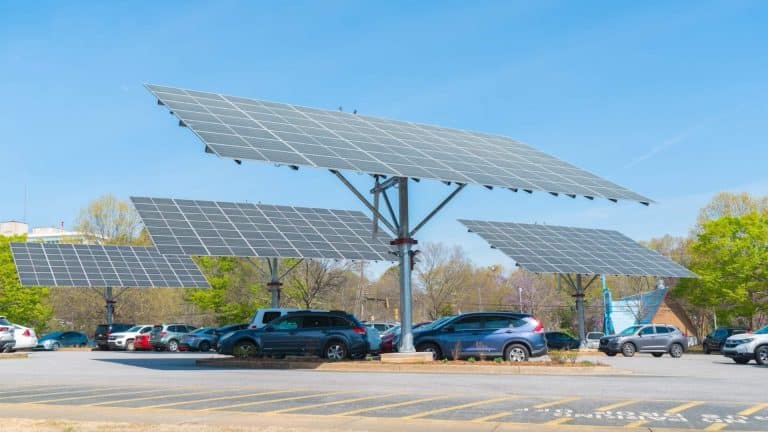[button color=”blue” url=”https://bit.ly/decarbondownload21″]Download the Report [/button]
[button color=”blue” url=”https://cleanenergy.org/news-and-resources/tracking-decarbonization-in-the-southeast-2021-report-webinar/”] Watch the Report Webinar [/button]
Climate science shows we need to get to net-zero global greenhouse gas emissions between 2040 and 2055 at the latest to limit the global average temperature increase to 1.5 degrees C and avoid the worst of the climate crisis. Many utilities and municipalities are beginning to acknowledge that dynamic, but SACE’s third annual “Tracking Decarbonization in the Southeast“ report shows there’s still a lot of work to do before any of them are on track to reach net-zero.
Why focus on decarbonizing the power sector specifically?
While emissions reduction opportunities exist all over the world and in many different sectors, in this report we focus on the decarbonization of the electric power sector of the Southeastern United States. Decarbonization is the transition of our power supply to sources that emit lower CO2 emissions.
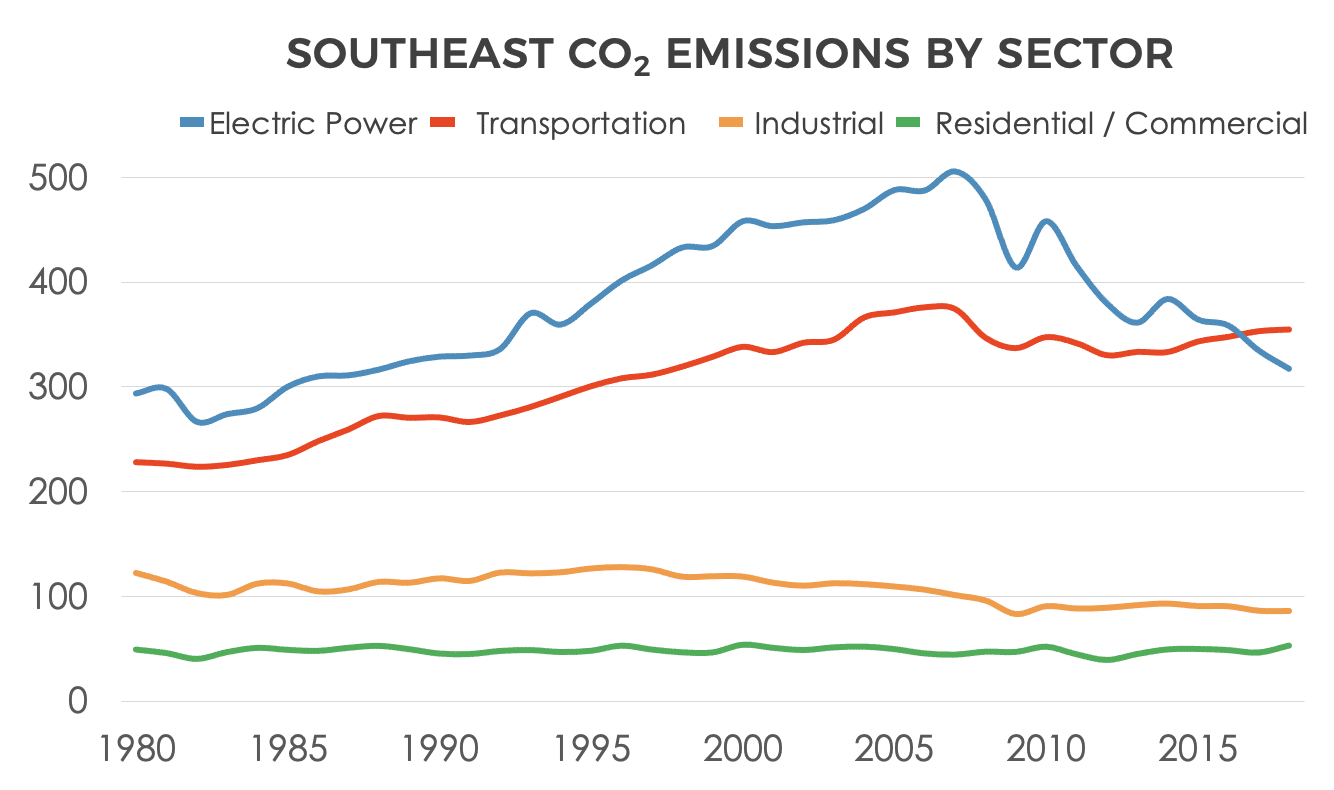
Power sector emissions have sharply fallen from their peak in 2007 to the point where the transportation sector is now the largest source of CO2 in most states and regions in the U.S. The fact that transportation has eclipsed the power sector does not diminish the importance of decarbonizing the power supply. In fact, this still holds a lot of significance for utilities in the Southeast, as more consumers, businesses, and local governments are beginning to drive electric. When electric vehicles (EV) are plugged in to charge, they’ll be using utility-generated power for their transportation needs. Therefore, the cleaner the electricity, the cleaner the EV. In fact, decarbonization of the power sector is a critical tool to reduce emissions in all sectors through electrification.
How do we measure decarbonization and why are we doing it?
The Southeast is home to some of the biggest utility systems in the nation, some of which have been in the national spotlight for establishing decarbonization goals. Duke Energy, Southern Company, NextEra Energy, and the Tennessee Valley Authority (TVA) are responsible for approximately three-quarters of emissions from power generation in the Southeast. Of these, the two largest CO2 emitters, Duke and Southern, have both made pledges to reach net-zero emissions by 2050, while NextEra has an emissions rate goal equivalent to a 40% total emissions reduction. TVA has made no formal commitments (though it has publicized expected reductions to which we reacted to in a different blog).
So how do we track the progress of these attempts? We look at the emissions associated with what utilities are planning to do, not just what goal they have set.
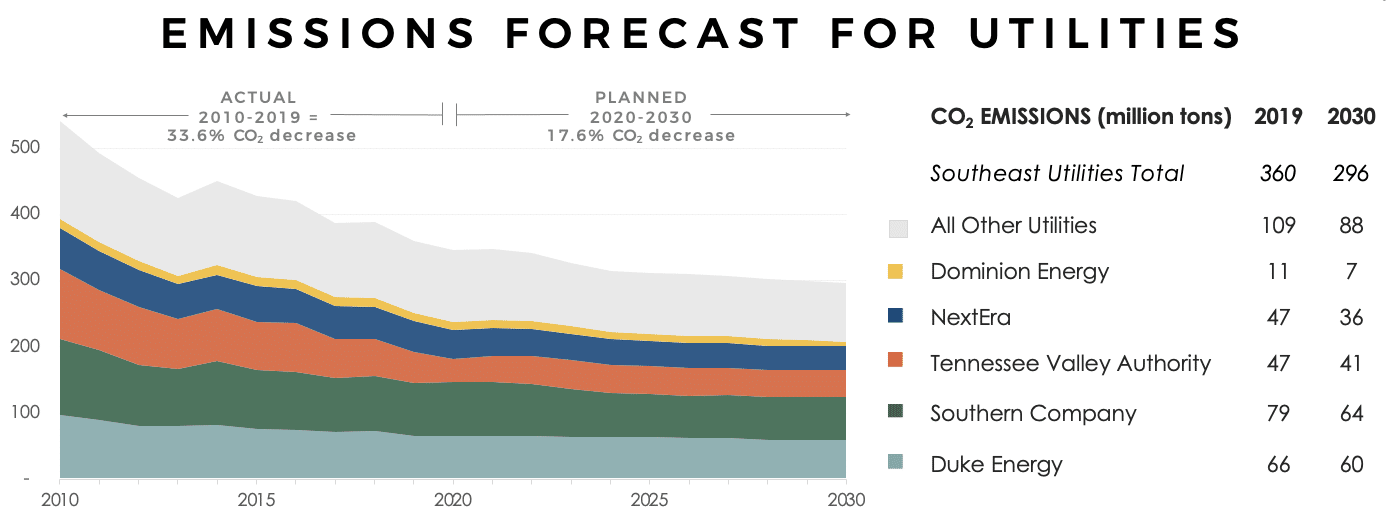
Since decarbonization is needed to avoid the worst impacts of the climate crisis, much of our report focuses on total emissions reductions and the rate of decarbonization. While the per megawatt-hour emissions intensity of the power supply can be useful for quickly comparing utilities against one another, it doesn’t necessarily tell us anything about when or if it’s possible for a utility to reach zero. Looking at how quickly absolute emissions reductions occur over longer timeframes gives us a window into just how long it will take to reach zero emissions based on the resource plans utilities have submitted to regulators.
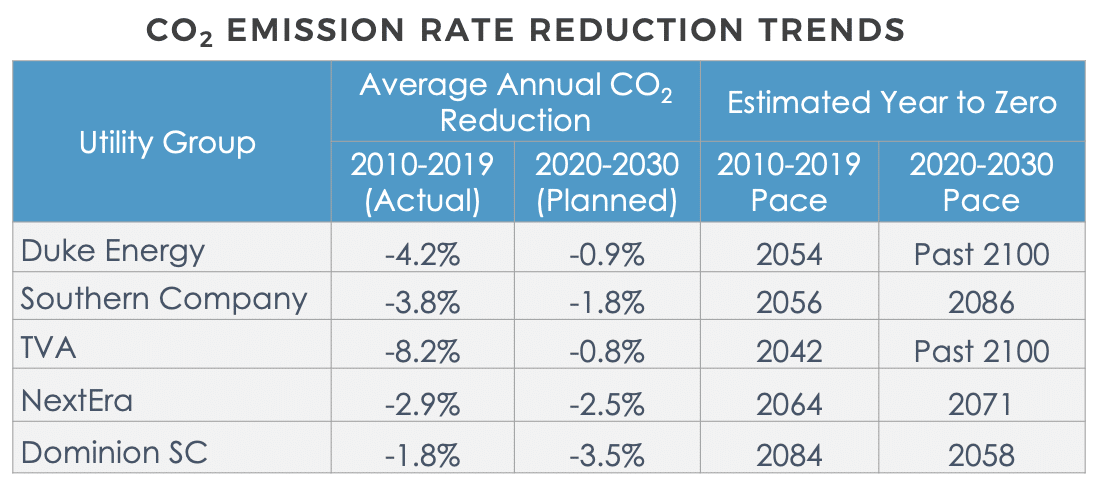
Most utilities were reducing carbon at a higher rate in the last decade than they plan to do in the coming decade. This is because most emission reductions from 2010-2019 were the result of flat or declining utility load paired with retiring coal generation and replacing it with fossil gas. Fossil gas is now the dominant fuel in the region, with many utilities still planning to add new gas infrastructure in the future. As a result, planned reductions are occurring much slower than in the past decade and at a rate that would miss even the latest decarbonization “deadline” by several decades. For utilities to decarbonize at the pace seen in the 2010s they will have to retire remaining coal plants at a steady pace and replace fossil gas with clean, zero-carbon energy sources like wind, solar, storage, and energy efficiency.
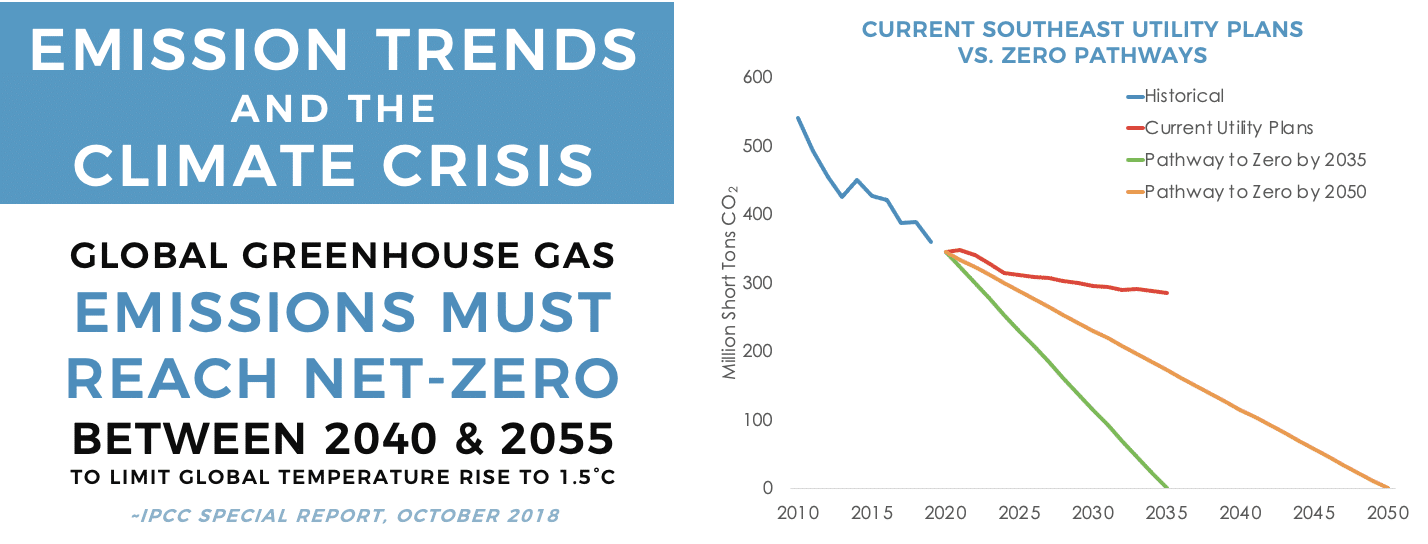
The good news in this year’s report? The regional trajectory of emissions based on current utility plans is better than when we published this report last year. So progress has been made. However, much more is still needed.
What Utilities Say vs. What They Do
There’s a growing consensus from customers, investors, and regulators: everyone wants utilities to provide a carbon-free power supply. Utilities have begun catering to this want by publicizing emissions reductions and in some cases announcing decarbonization goals with various stylings (net-zero, low to no carbon, carbon-free). However, scientists have been clear that decarbonizing isn’t really a want, it’s a need. And it’s becoming increasingly clear that utilities’ actions are not meeting this need.

While many electric utilities are eager to make it known they’ve reduced emissions in the past, fewer have announced a goal that takes scientific guidance into consideration. Notably, both NextEra and TVA focus heavily on per megawatt-hour carbon reduction, rather than total CO2 emissions. That might sound like an arbitrary distinction, but using NextEra Energy as an example, a 67% reduction in emissions rate actually equates to a 40% reduction in annual emissions because the utility has seen (and is expected to continue to see) demand growth. Only one utility, Duke’s two subsidiaries in the Carolinas, has taken the step to include its net-zero decarbonization goal in its Integrated Resource Planning (IRP), or long-term energy resource, planning process (though even that can fall short in some areas) and based on current resource plans, none are on track to decarbonize by 2035, 2040, or even 2050.
What next?
As a long-time intervenor in utility regulation, SACE has long contended (and still does) that utility resource planning remains one of the best opportunities for utilities to put decarbonization goals into practice. However, as we can see from the report, action is still not happening fast enough. Other tools that could bring about rapid decarbonization of the sector in the Southeast include a competitive market in the region; improvements to renewable and energy efficiency policies at the state level; and a federal Clean Electricity Standard (CES).
A CES is a regulatory tool requiring utilities to increase their portfolio of clean energy on a deadline until it accounts for 100% of the power supply. Clean Electricity Standards have strong bipartisan support throughout the country: 29 states and the District of Columbia currently have them, and eight more states have clean energy goals. The concept has had bipartisan support in Congress as well, and several versions of a CES have been proposed in the 117th Congress, including the CLEAN Future Act as well as a 100% carbon-free electricity by 2035 plan in President Biden’s American Jobs Plan. Because the Southeast lacks state-level Renewable Portfolio Standards (with the exception of North Carolina) and a competitive electric market, both of which have driven clean energy in other parts of the country, a federal CES would have an outsized impact on the future resource plans of Southeastern utilities.
Advocating for a CES is also a rare opportunity for the entire region to unify around one advocacy goal – everyone has an elected official who can play a part in this legislative effort. If you think the Southeast can do better, take action: urge Congress to support 100% clean electricity by 2035.

[button color=”blue” url=”https://secure.everyaction.com/YSD8hkgryEGN2wAxVeiZsQ2″]Take Action: Urge Congress to Pass a 100% Clean Electricity Standard[/button]
#SEDecarbonizationReport21

